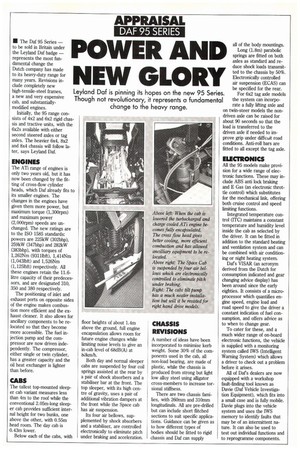POWER AND NEW GLORY
Page 61

If you've noticed an error in this article please click here to report it so we can fix it.
Leyland Daf is pinning its hopes on the new 95 Series. Though not revolutionary, it represents a fundamental change to the heavy range.
• The Daf 95 Series — to be sold in Britain under the Leyland Daf badge — represents the most fundamental change the Dutch company has made to its heavy-duty range for many years. Revisions indude completely new high-tensile-steel frames, a new and very expensive cab, and substantiallymodified engines.
Initially, the 95 range consists of 4x2 and 6x2 rigid chassis and tractive units, with the 6x2s available with either second steered axles or tag axles. The heavier 6x4, 8x2 and 8x4 chassis will follow later, says Leyland Daf.
ENGINES
The ATi range of engines is only two years old, but it has now been changed by the fitting of cross-flow cylinder heads, which Daf already fits to its smaller engines. The changes in the engines have given them more power, but maximum torque (1,300rpm) and maximum power (2,000rpm) speeds are unchanged. The new ratings are to the ISO 1585 standards: powers are 225kW (302bhp), 259kW (347bhp) and 282kW (383bhp), with torques of 1,262Nm (93111bft), 1,414Nm (1,0431bft) and 1,526Nm (1,1251bft) respectively. All these engines retain the 11.6litre capacity of their predecessors, and are designated 310, 350 and 380 respectively.
The positioning of inlet and exhaust ports on opposite sides of the engine makes combustion more efficient and the exhaust cleaner. It also allows for ancillary components to be relocated so that they become more accessible. The fuel injection pump and the compressor are now driven independently. The compressor, either single or twin cylinder, has a greater capacity and the oil heat exchanger is lighter than before.
CABS
The tallest top-mounted sleeper cab variant measures less than 4m to the roof while the conventional 2.05m-long sleeper cab provides sufficient internal height for two bunks, one above the other, with 0.55m head room. The day cab is 0.43m lower.
Below each of the cabs, with floor heights of about 1.4m above the ground, full engine encapsulation allows room for future engine changes while limiting noise levels to give an in-cab level of 68dB(A) at 80km/h.
Both day and normal sleeper cabs are suspended by four coil springs assisted at the rear by a pair of shock absorbers and a stabiliser bar at the front. The top sleeper, with its high centre of gravity, uses a pair of additional vibration dampers at the front while the Space cab has air suspension.
Its four air bellows, supplemented by shock absorbers and a stabiliser, are controlled electronically to eliminate pitch under braking and acceleration.
CHASSIS REVISIONS
A number of ideas have been incorporated to minimise kerb weight. Some 30% of the components used in the cab, all non-load bearing, are made of plastic, while the chassis is produced from strong but light low alloy steel using alligator cross-members to increase torsional stiffness.
There are two chassis families, with 260mm and 310rnm longitudinals. All are pre-drilled but can include short flitched sections to suit specific applications. Guidance can be given as to how different types of bodies should be fitted to rigid chassis and Daf can supply all of the body mountings.
Long (1.8m) parabolic springs are fitted on both axles as standard and reduce shock loads transmitted to the chassis by 50%. Electronically controlled air suspension (ECAS) can be specified for the rear.
For 6x2 tag axle models the system can incorporate a fully lifting axle and on twin-steer models the nondriven axle can be raised for about 90 seconds so that the load is transferred to the driven axle if needed to improve grip under difficult road conditions. Anti-roll bars are fitted to all except the tag axle.
ELECTRONICS
All the 95 models make provision for a wide range of electronic functions. These may include ABS anti lock braking and E Gas (an electronic throttle control) which substitutes for the mechanical link, offering both cruise control and speed limiting functions.
Integrated temperature control (ITC) maintains a constant temperature and humidity level inside the cab as selected by the driver. It can be fitted in addition to the standard heating and ventilation system and can be combined with air conditioning or night heating system.
Dafs VISAR (an acronym derived from the Dutch for consumption indicated and gear changing advice display) has been around since the early eighties. It consists of a microprocessor which quantifies engine speed, engine load and road speed to give the driver a constant indication of fuel consumption, and offers advice as to when to change gear.
To cater for these, and a much wider range of on-board electronic functions, the vehicle is supplied with a monitoring system called IWS (Intelligent Warning System) which allows a driver to check out a problem before it arises.
All of Daf s dealers are now equipped with a workshop fault-finding tool known as Davie (Daf Vehicle Investigation Equipment), which fits into a small case and is fully mobile. Davie plugs into the vehicle system and uses the IWS memory to identify Emits that may be of an intermittent nature. It can also be used to test out individual functions and to reprogramme components.




























































































